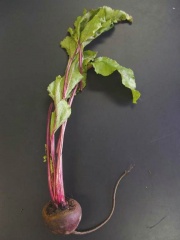Difference between revisions of "Beet"
Jump to navigation
Jump to search
| (One intermediate revision by the same user not shown) | |||
| Line 1: | Line 1: | ||
| − | [[File:Beta_vulgaris.jpg|thumb|Beet plant | + | [[File:Beta_vulgaris.jpg|thumb|Beet plant (''Beta vulgaris'')]] |
== Description == | == Description == | ||
| Line 18: | Line 18: | ||
* ''The American Heritage Dictionary'' or ''Encarta'', via Microsoft Bookshelf 98, Microsoft Corp., 1998 | * ''The American Heritage Dictionary'' or ''Encarta'', via Microsoft Bookshelf 98, Microsoft Corp., 1998 | ||
| − | * Wikipedia | + | * Wikipedia at http://www.wikipedia.com |
[[Category:Materials database]] | [[Category:Materials database]] | ||
Latest revision as of 14:59, 22 October 2022
Description
A common plant of the genus Beta (such as Beta vulgaris), with thick reddish roots. The roots produce sugar and a reddish brown extract that has been used for dyeing textiles.
Synonyms and Related Terms
Beta vulgaris (Common beet); betaniini (Fin.); betanina (Esp.); betterave (Fr.); barbabietola (It.); vermelho de beterraba (Port.); betanin (Sven., Nor.); bietenrood (Ned.); beetroot; beet red; beetrot red; blood turnip
Resources and Citations
- R.J. Adrosko, Natural Dyes in the United States, Smithsonian Institution Press, Washington, DC, 1968
- G.S.Brady, Materials Handbook, McGraw-Hill Book Co., New York, 1971 Comment: p. 780
- Random House, Webster's Encyclopedic Unabridged Dictionary of the English Language, Grammercy Book, New York, 1997
- The American Heritage Dictionary or Encarta, via Microsoft Bookshelf 98, Microsoft Corp., 1998
- Wikipedia at http://www.wikipedia.com
